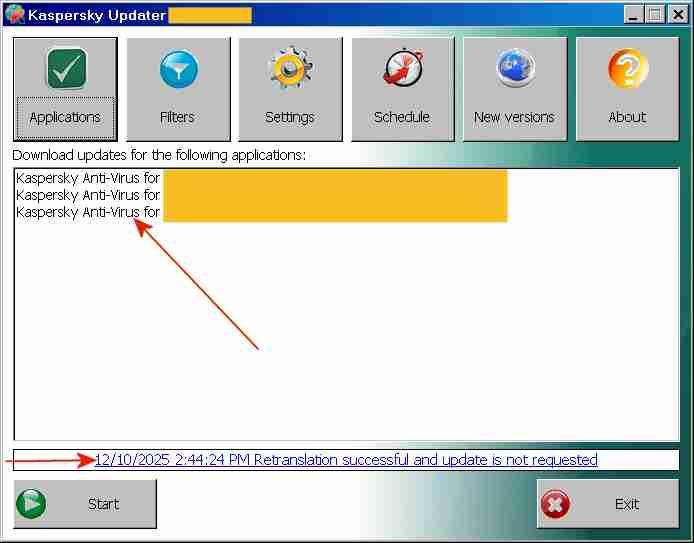
Multibooter
Member-
Posts
1,096 -
Joined
-
Last visited
-
Days Won
1 -
Donations
0.00 USD
Multibooter last won the day on December 27
Multibooter had the most liked content!
About Multibooter

Profile Information
-
OS
98SE
Recent Profile Visitors
5,373 profile views
Multibooter's Achievements
103
Reputation
-
KB2839299_2003 derived fltMgr upgrade that it is not...
Multibooter replied to modnar's topic in Windows XP
Besides speed, system stability could be another criteria for deciding between fltmgr.sys build 5107 and build 6912 under WinXP. eMule could be used for comparing system stability/uptime when running with fltmgr.sys build 2180 [WinXP SP2] vs build 5107 vs build 6912. eMule, installed under WinXP SP2 and running 24/7 on a dedicated old Inspiron laptop (500MHz, SSE-only, 512MB RAM), tends to crash with the original fltmgr.sys build 2180 after downloading for 7-14 days. Build 5107 has been installed to see whether it can increase eMule uptime, i.e. system stability. -
https://www.virustotal.com/gui/file/767b877e735c425bf05c34683356abfde4070b092f17a4741ea5ac490611f3de https://www.virustotal.com/gui/file/9f805311953057a944567d9a2e45ee4d65ffb7804925115b3b05bf02d3ff7821
- 1,279 replies
-
- Security
- Antimalware
-
(and 3 more)
Tagged with:
-
Thanks, AstroSkipper. But pw-protected "ProxHTTPSProxy_TLS_1_3_1_5_220717_PopMenu_3V3_CheckedByAstroSkipper.7z", containing your software package, has still the same issue (false positives by Kaspersky) which I posted on 14Jan2025, https://msfn.org/board/topic/183352-proxhttpsproxy-and-httpsproxy-in-windows-xp-for-future-use/page/61/ cacert_updater.exe and cmdow.exe inside your package still get flagged as Trojan and riskware by Kaspersky. mediafire: "This file was uploaded from Germany on January 14, 2025 at 9:50 AM" I surely want to believe that your package is clean. Maybe you can make these two files look clean or replace them, not just password-protect them? Many good little files have disappeared into oblivion because they were flagged.
- 1,279 replies
-
1
-
- Security
- Antimalware
-
(and 3 more)
Tagged with:
-
Owned 100% by a U.S. company with U.S. government contracts? On the other side of the globe: Eugene Kaspersky's background? Searching with the Yandex search engine for: Kaspersky Putin lists interesting articles, for example the 2012 article https://www.brookings.edu/articles/russias-top-cyber-sleuth-foils-us-spies-helps-kremlin-pals/
- 1,279 replies
-
- Security
- Antimalware
-
(and 3 more)
Tagged with:
-
That looks too tricky to me, at least for testing Panda. Do you have simple instructions for installing the TLS stuff under WinXP? In contrast, updating the various versions and editions of My ancient version of Kaspersky in one swoop is quite simple. I just use a little corporate utility, Kaspersky Updater, to create/update a single update distribution folder from which 30+ Kaspersky programs can be updated off-line. Below is a screenshot of this little corporate utility, which I used for updating 3 different Kaspersky programs, the normal workstation edition, the specced-down workstation edition and the server edition. This screenshot shows the signature update of 10Dec2025 for my posting "My ancient version of Kaspersky under Windows 10" of 15Dec2025. https://msfn.org/board/topic/184730-antimalware-firewall-and-other-security-programs-for-windows-xp-working-in-2023-and-hopefully-beyond/page/82/#comments The message "... Retranslation successful" means that the update was successful and that the update distribution folder was filled OK. No idea what the part "and update is not requested" refers to. Kaspersky Updater here was run under Windows Server 2003 (blue window title) and updating under WinXP and Win10 from the update distribution folder worked OK. No need to register with an email address and to fiddle around with TLS stuff under WinXP.
- 1,279 replies
-
- Security
- Antimalware
-
(and 3 more)
Tagged with:
-
Using different emails does NOT protect your privacy. United States spy agencies identify people by name, email address(es), phone numbers, IP numbers assigned etc. OT: the header of a Jeffrey Eppstein FBI file recently released indicates also the IP number as a personal identification trait, together with the date of birth. https://web.archive.org/web/20251227130144/https://www.miamiherald.com/public/latest-news/2wwvfa/picture313924496/alternates/FREE_1140/Screenshot 2025-12-23 115102.png In many countries the router IP number assigned by Internet providers is nearly impossible to change. You can pull the power plug of the router and reconnect it, but still the same router IP number.
- 1,279 replies
-
- Security
- Antimalware
-
(and 3 more)
Tagged with:
-
An old email address at GUERRILLA MAIL still works, but not the Panda activation. After entering the email address in window "Activate Panda Dome", Panda dome displays "Error checking the account. We're sorry but we were unable to access your Panda account. Make sure you have an Internet connection and try again." Same issue with FAKE MAIL GENERATOR, the same error message by Panda Dome. So either some disposable email addresses are black-listed by Panda Security or activation requires additional TLS stuff, or both
- 1,279 replies
-
- Security
- Antimalware
-
(and 3 more)
Tagged with:
-
Maybe here is the solution to the low detection rate of Panda Dome: As described my earlier posting above, I did NOT activate Panda Dome. Therefore there was no apparent need to install ProxHTTPSProxy, HTTPSProxy or ProxyMII under WinXP as described in AstroSkipper's posting of 20Dec2025 https://msfn.org/board/topic/184730-antimalware-firewall-and-other-security-programs-for-windows-xp-working-in-2023-and-hopefully-beyond/page/83/#findComment-1284113 My old Inspiron 7500 is connected to the Internet via Ethernet, and the activity light of the Ethernet PC Card does NOT indicate any uploading activity during virus-checking by Panda Dome, i.e. Panda Dome is apparently using a built-in, rudimentary signature set, and was not uploading files for online checking. Panda Dome, however, did NOT give any messages that the virus-checking is incomplete and no online checking took place, e.g. because Panda Dome was not activated or because of a TLS problem. The two reviews by tomsguide and techradar, quoated in my earlier posting, were from the top search results displayed by the Yandex search engine. For my testing of Panda Dome I have been re-using "My personal in the Wild", described in my posting of 6Jul2024 (please scroll down there) https://msfn.org/board/topic/184730-antimalware-firewall-and-other-security-programs-for-windows-xp-working-in-2023-and-hopefully-beyond/page/70/#comments I do not want to enter my email address to activate Panda Dome, so I am done with my testing of Panda Dome.
- 1,279 replies
-
- Security
- Antimalware
-
(and 3 more)
Tagged with:
-
Reviews: "Panda's ability to catch malware lags behind that of many other free security products," from: https://www.tomsguide.com/us/panda-free-antivirus,review-3524.html "Its security scores may not be consistently impressive" from: https://www.techradar.com/pro/security/panda-dome I was also surprised at the score of 6/100. I initially thought that I had a wrong setting in Panda. The 100 files in my sample were from actual downloads from eMule, together with many good, clean files. I have two 2TB HDDs with flagged stuff from eMule, and could have increased the sample size to 10,000 infected files from eMule, but an initial check with 100 randomly picked infected files was good enough for me. I only wanted for myself an initial glance at the approximate detection capability of stuff from eMule, which may be different from the results of official tests by the professionals.
- 1,279 replies
-
2
-
- Security
- Antimalware
-
(and 3 more)
Tagged with:
-
According to the User Guides of the normal workstation edition and of the specced-down workstation edition for virus-checking, My ancient version of Kaspersky works Ok with Windows XP Professional x64 (SP2 or higher).
- 1,279 replies
-
- Security
- Antimalware
-
(and 3 more)
Tagged with:
-
I test-downloaded it, kerio-pf-2.1.5-en-win.exe is the identical installer file of v2.1.5 which I have been using under WinXP since 2008. After registering, the Registration tab in the window "Administration" changes to a License tab. One issue I remember was that Kerio crashed sometimes when a program was running in a sandbox under Sandboxie v5.22 under WinXP. I then unloaded Kerio while the program was running in the sandbox. After having finished running the sandboxed program I re-started Kerio. Another minor issue is a bloated filter.log file. Writing to the .log file can be disabled by -> Advanced button -> Miscellaneous tab -> de-select Log into file (filter.log). Disabling writing to the logfile has made uTorrent v3.3.2.30488 (17Jan2014) a little faster on my slow Inspiron 7500 (700MHz Pentium III).
- 1,279 replies
-
1
-
- Security
- Antimalware
-
(and 3 more)
Tagged with:
-
Yes, All Antivirus settings are green = enabled (Scan compressed files, Behavioral analysis etc) except for "Show warning upon detection" and "Scan after cache synchronization"
- 1,279 replies
-
- Security
- Antimalware
-
(and 3 more)
Tagged with:
-
Thanks. I first installed MS .NET Framework v4.0 (18Mar2010) under WinXP SP3. Then I installed OK Panda Dome v21.01.00 under WinXP. I selected "Offline installation" during installation. I have not yet activated the program because activation requires entering an email address. After the first run the Settings window indicates "Last updated 12/26/2025". First the good news: Panda Dome v21.01.00 runs OK under WinXP on my old Inspiron 7500 (700 MHz Pentium III, SSE-only). The program does not seem have a conflict with other programs installed. Kerio Personal Firewall v2.1.5 has no issues with the program. It is even possible to run My Ancient version of Kaspersky simultaneously with Panda Dome, no conflict. Now the bad news: I made a virus-check with Panda Dome v21.01.00 of "My personal in the Wild", which is a collection of 100 infected files downloaded with eMule. I had prepared this collection a year and a half ago for testing-purposes by taking at random 100 files from a HDD full of infected downloads from eMule. Panda Dome v21.01.00 flagged only 6/100 files [msg: 8,531 scanned, 7 detected, i.e. 1 file was flagged twice, because of multiple infections], Only 6 files were quarantined, and 94 infected files were left as "clean" in the folder \My personal in the Wild_6Jul2024\ For comparison: When I ran My ancient version of Kaspersky with this test set of 100 infected eMule files, Kaspersky scanned 171,873 files contained in the various .rar, .zip, .exe etc in \My personal in the Wild_6Jul2024\ and, detected 167 viruses, trojans etc. 99 files were cleaned, the single file which was flagged but not cleaned was a .rar file containing in turn infected multi-part .rar files. Panda Dome v21.01.00 does NOT install under Windows Server 2003 SP2. When I tried to install it under Win2003 SP2 I got the incorrect error message: "You must upgrade your version of .NET Framework". Panda Security apparently did not prepare a recent corporate edition for Windows Server, maybe no demand. Kerio Firewall flags a file named "TUNNEL.EXE", which has to be given permissions. Which IT-Manager would be inclined to license software which opens a tunnel into corporate computers? BTW, Panda Security is a Spanish company https://en.wikipedia.org/wiki/Panda_Security which was acquired in March-June 2020 by the U.S. company WatchGuard https://en.wikipedia.org/wiki/WatchGuard BTW, Kerio Personal Firewall v2.1.5 (30Apr2003) does not have a Server version either, but is still my favorite firewall under WinXP.
- 1,279 replies
-
2
-
- Security
- Antimalware
-
(and 3 more)
Tagged with:
-
KB2839299_2003 derived fltMgr upgrade that it is not...
Multibooter replied to modnar's topic in Windows XP
I have now installed fltmgr.sys build 5107 also under WinXP SP3 on my i7 desktop computer, by booting into Win10 and then copying fltmgr.sys onto the WinXP partition. fltmgr.sys build 5107 works fine on the 3.4GHz i7 desktop under WinXP SP3 and WinXP feels a little crisper The updated fltmgr.sys is a must-have for slow computers under WinXP, and a nice-to-have for WinXP on fast computers. The remaining question now is: Which build of fltmgr.sys is the best one for WinXP SP3?






